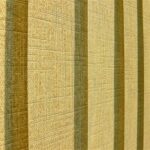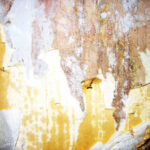If your home has paneled or cement block walls, then paint isn’t your only option when it comes to updating the look of the room. With a little preparation work, both of these types of surfaces can be covered effectively with wallpaper. By following these simple tips the room you thought you were stuck with forever can breathe new life again!
Before attempting to wallpaper your paneled or cement block walls, you must first find wallpaper liner at your local home improvement or wallpaper store. Wallpaper liner is essentially a heavy-duty unprinted paper that is applied to the wall before you put the printed paper on the walls. The wallpaper liner leaves a smooth surface for the wallpaper to grip, and because of it’s thickness it can cover a lot of unevenness in the walls. However, the wallpaper liner alone won’t cover everything, so it’s necessary to do some prep work to your walls before you begin.
On paneled walls, start with nailing down loose seam or panels. Be sure to pull out any loose nails and replace with drywall screws if necessary to secure the paneling solidly to the wall. Since most paneling is grooved, use a surfacing compound to fill in the grooves and provide a more level surface to adhere the wallpaper liner to the wall. Once the surfacing compound has dried, use a 200 grit sandpaper to create a smooth surface for the wallpaper liner to be attached.
On cement block walls, it’s important to first check for signs of mildew or efflorescence, which can appear as a powdery reside on the wall. Signs of either of these can mean that there is excessive moisture in the block, making it unlikely to accept wallpaper. Concrete block walls in basements are especially susceptible to excess moisture. If you feel that your concrete walls are in good enough condition to proceed, then use surfacing compound to fill in any cracks or spaces in the block and sand the wall the same as you would with a paneled wall.
Regardless of the surface you’re dealing with, it’s important to clean the walls with a 50-50 mixture of ammonia and water or a trisodium phosphate (TSP) cleaner. Wash the walls thoroughly to remove any buildup of dust or grease and rinse with water until it runs clear. Allow the surface to dry completely for at least 24 hours before proceeding further.
Once your walls have completely dried, paint them with a combination of primer/sealer/sizing. The primer/sealer/sizing combination used to be a three part application, but can now be achieved by applying one product to the wall. The sealer prevents water, smoke and other stains from showing through the paper. Primer provides a smooth surface for the paper to stick too, and the sizing is a thin wallpaper paste that soaks into the pores to prevent the paste from soaking through.
When your primer/sealer/sizing has dried, it’s time to apply the wallpaper liner to the wall. Wallpaper liner is sold unpasted, which means it’s necessary to apply a layer of wallpaper paste to the back of the liner before attaching it to the wall. Put the strips of wallpaper liner on the wall horizontally, so that the seams of the liner and the actual wallpaper won’t fall in the same location.
Once the wallpaper liner has completely dried, inspect it for any high or low spots and then hang your wallpaper as you would do on any other wall.
By taking a few extra steps in the wallpaper process, no wall is off limits and you’re free to let your creative side go wild!





